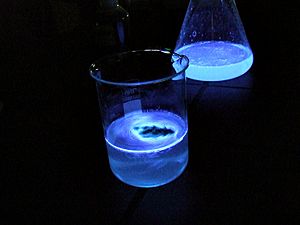Luminescence facts for kids

Luminescence is a special way some things make light without getting hot. Think of a glow stick or a firefly! This is different from a light bulb, which gets super hot to make light. That kind of light is called incandescence.
Luminescence can happen because of many things. It might be a chemical reaction, like in a glow stick. It could also be from electricity, tiny movements inside atoms, or even from squeezing certain crystals (this is called piezoelectricity). The word 'luminescence' was first used in 1888 by a scientist named Eilhard Wiedemann.
Sometimes, the dials and signs on airplanes or boats are coated with special glowing materials. This process is called 'luminising'. It helps pilots and sailors see the instruments in the dark.
Contents
How things Glow: Types of Luminescence
There are several exciting ways that substances can produce light without heat. Each type has its own unique trigger.
Chemiluminescence
Chemiluminescence is when light is made from a chemical reaction. It's like magic, but it's science! When certain chemicals mix, they release energy as light instead of heat.
Bioluminescence
Bioluminescence is a super cool type of chemiluminescence. It's when living things, like fireflies, jellyfish, or some deep-sea fish, make their own light. They do this using special biochemical reactions inside their bodies. It helps them find food, attract mates, or even scare away predators.
Fluorescence
Fluorescence happens when a substance glows right after it absorbs higher-energy light, like ultraviolet (UV) light. As soon as the UV light hits it, the substance immediately gives off visible light. Think of a highlighter pen under a blacklight – that's fluorescence! The glow stops as soon as the UV light is removed.
Phosphorescence
Phosphorescence is similar to fluorescence, but with a cool twist. The substance absorbs light, but it doesn't glow right away. Instead, it stores the energy and releases it slowly over time. This means it can keep glowing for minutes or even hours after the original light source is gone. Glow-in-the-dark stars on your ceiling are a great example of phosphorescence.
Electroluminescence
Electroluminescence is when a material makes light when an electric current passes through it. The most common example you see every day are Light-emitting diodes (LEDs). These tiny lights are super energy-efficient and are used in everything from phone screens to traffic lights.
Images for kids
See also
 In Spanish: Luminiscencia para niños
In Spanish: Luminiscencia para niños


